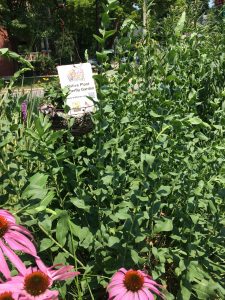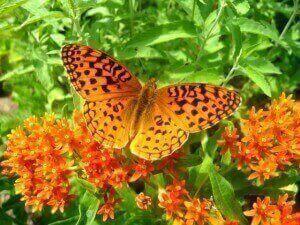West Cook Wild Ones Wildlife Corridor
West Cook Wild Ones Wildlife Corridor Map–Watch It Grow
Our goal is to gather pledges from at least two yards/landscapes (public or private) on every block between Thatcher Woods and Columbus Park. To pledge your yard send an e-mail to [email protected]
West Cook Wild Ones has been engaging residents and organizations in creating landscapes that feature native shrubs, trees, plants, and grasses as a way to increase biodiversity in the Oak Park/River Forest area (including Chicago, Berwyn and other surrounding towns). We hope that with enough yards acting as habitats for wildlife, we can support populations of beneficial species who are here either as year-long residents or as migrants. Because Wild Ones has chosen to focus on species that fly due to our urban infrastructure (e.g., amphibians would not be feasible), we expect to see an increase in movement as well as an increase in population if more native trees, shrubs, and plants are planted and tended in an ecologically sensitive manner.

What is a Wildlife Corridor?
According to Conservation Corridor, a group of researchers whose mission is to bridge the science and practice of conservation corridors, corridors are habitats that are typically long relative to their width. Corridors work by increasing connectivity between patches that are isolated because of habitat fragmentation, due primarily to urbanization, agriculture, and forestry (Conservation Corridor). Habitat fragmentation impacts animal and plant populations because they are not able to rebound from habitat disturbance (e.g., fire) or disease since the organisms cannot move easily from one area to another. Since populations are cut off from each other, reduced genetic diversity is another result. Habitat fragmentation due to human activity is an ever-increasing threat to biodiversity, so habitat/wildlife corridors are a possible mitigation.
What are some examples of Wildlife Corridors?
As many people know, the Monarch butterfly has been experiencing an alarming reduction in population due to several factors, one of the most critical being loss of habitat. An illustration of how effective a wildlife corridor can be is found in a study that was conducted in South Carolina. This study showed butterflies using connected remnant (i.e., a small remaining fragment) 2-4 times more often than unconnected patches. This same experiment also showed that seed and pollen movement, as well as fruit set mirrored the movement of the butterflies studied.
On a much larger scale, many tiger populations face a variety of threats, including habitat fragmentation, encroachment, poaching and developmental projects. As part of their protection program, India has a 37-mile long, 6-mile wide corridor that connects important tiger habitats in the Eastern Himalaya and the Western Ghats mountain ranges.
A recent study on birds in urban areas confirms that our yards can serve as important habitats for birds: http://conservationmagazine.org/2015/04/backyards-could-be-a-boon-for-urban-birds/. Here is a video featuring the scientists talking about their study and how to help birds: https://www.youtube.com/watch?v=3TbrD34qS2Q&feature=youtu.be
Why should we create corridors?
Without changing how we treat our landscapes, we risk losing many of the other species here on earth because ecosystems begin with plants that are native to a region. In the U.S. most of our yards are dominated by non-native lawns, plants, trees, and shrubs from Asia or Europe. This state of affairs along with loss of habitat and other human-caused factors is increasing the extinction rate. A recent study (based in Europe but could be extrapolated here) indicates that different species have different rates of extinction debt–it can take decades for us to really see the effects of habitat loss: http://news.mongabay.com/2013/0415-hance-biodiversity-debt.html
Invasive species can be traced back to introductions from the horticultural trade, and these invasive species destroy our ecosystems.
The animals and plants that have lived here are integral parts of our ecosystems, and ecosystems provide humans with many services. Examples of ecosystem services include, clean air, water, medicine, food, building materials, pollination, pest and disease control, technological progress.
It can be argued that humanity is not sustainable without these other plants, animals, and organisms that also live on Earth. Scientists are just beginning to understand the importance of biodiversity for ecosystems and the services we derive from them. Read: Biodiversity Promotes Multitasking in Ecosystems. Besides their ecological benefits, native plants improve the soil, improve water drainage/retention, and sequester carbon. Once correctly sited (receiving their required light, soil, and water conditions) and established (young seedlings and transplants need supplemental watering in the first year), native plants are low-maintenance.
What can I do and/or how can become involved?
- Plant native trees, shrubs, and plants, especially host and nectar plants and let us know at [email protected], so we can add you to our Corridor map.
- Become a member of West Cook Wild Ones and come to our programs
- Start an organic vegetable garden and/or join a CSA or community garden (many herbs are host plants for butterflies)
- Do NOT use pesticides
- Do NOT use lawn services that use synthetic fertilizers (waste of $) or mow and blow – i.e., using loud machines that emit high levels of CO2 and leaf blowers that blow away possible overwintering butterflies and other beneficial insects
- Water for butterflies should be provided in the form of a puddle in a sunny area, preferably near the butterfly garden. Containers could be a small trench in the soil lined with plastic, a plastic pail buried in the ground, or a dish or platter. Fill the container with sand. Place a few rocks and twigs on the sand to provide landing sites within reach of the water. Then fill the container with water to the level of the sand. Such puddles are those sought by butterflies, not bird baths, ponds, or large water features (taken from University of Vermont Extension).
- Provide water for birds (clean, fresh water is appreciated by birds)
- Prevent bird collisions into house/business windows
- Allow some area of your yard to be undisturbed habitat which will help support our native bees and other beneficial insects
- Volunteer for habitat restoration workdays with the Forest Preserves
- Become a Citizen Scientist monitor birds, plants, insects, etc.
Can you think of more ways to become involved?


